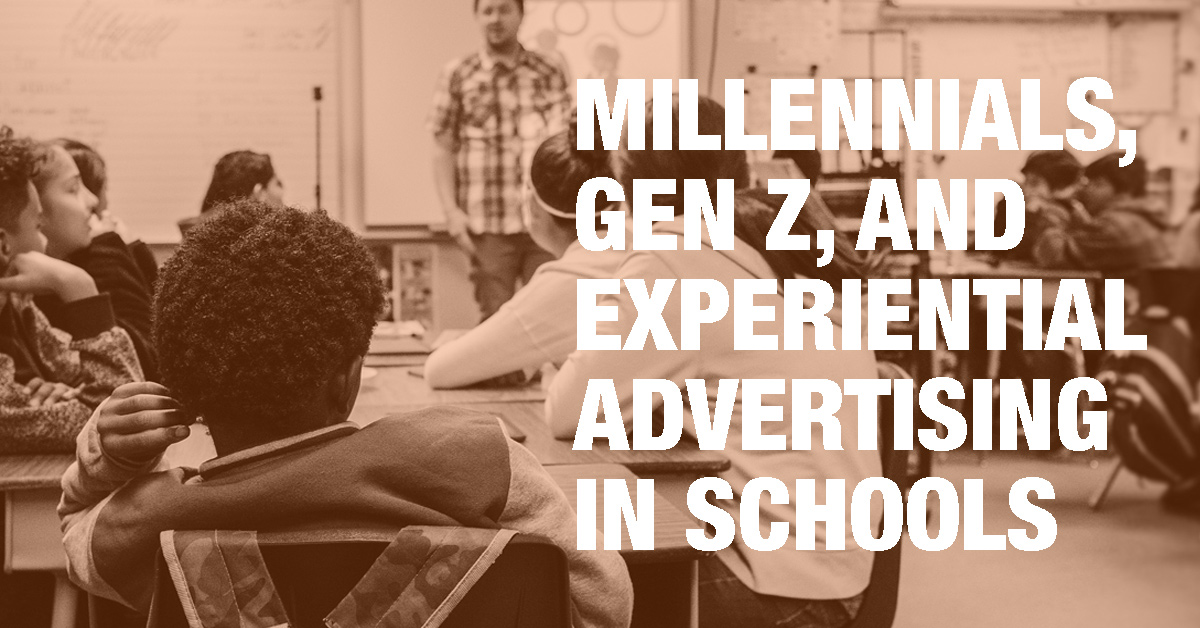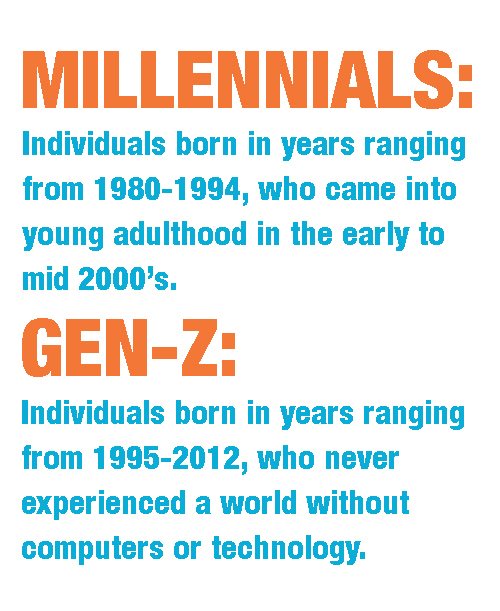
The rise to demographic prominence of millennials and the members of Gen Z has caused a shift in today’s advertising landscape. Advertisers everywhere are looking for new tactics and strategies capable of reaching these seemingly elusive generations. Experiential advertising has seen some success in catching their attention, but to make a more meaningful impact these isolated campaigns need to expand their reach. Experiential campaigns are just beginning to move into schools, but it’s not entirely clear what makes these demonstrations so effective. This post will examine what elements of experiential are so appealing to younger audiences, and how the movement into schools can be navigated efficiently, and responsibly.
Advertising In Schools: What does the current system look like?
Advertising in schools is not a new concept. Advertising is already very prevalent on college campuses, but recently some marketers attentions’ have shifted towards advertising in primary, middle, and high schools instead. With districts nationwide struggling to make up for budget cuts, schools everywhere are turning to the private sector and selling advertising rights in return for additional funding.
“Advertisements provide additional ways to support students, they offset tax increases and help to avoid cutting programs,” says Dr. W. David Bowman, of Pennsbury School District.
Advertisements that are currently being placed in schools must follow a relatively strict set of rules. Ads can only be placed in certain areas that are designated by the school, they must contain at least some form of broad educational messaging, and they must never seep into the actual classrooms, as students would have no way to filter out these ads during their mandatory class time. Although advertising in schools is legal, effective, and regulated, many parents still question the ethicality of the practice. So before placing any physical advertisements, it is essential to carefully consider their concerns.
Millennials and Gen Z: Why Do Younger Generations Like Experiential?
Millennials and the members of Gen Z are different. They interact with technology very differently than the generations that preceded them (Baby Boomers & Gen X), and as a result, their interactions with advertising are very different as well. Members of these generations have been said to be able to interpret and ignore traditional forms of media at speeds 20-50% faster than other generations. So impacting them in a way that is impossible for them to ignore is crucial.
than the generations that preceded them (Baby Boomers & Gen X), and as a result, their interactions with advertising are very different as well. Members of these generations have been said to be able to interpret and ignore traditional forms of media at speeds 20-50% faster than other generations. So impacting them in a way that is impossible for them to ignore is crucial.
That’s where experiential comes in. It is often suggested that the single most important factor to focus on when creating an advertisement to impress these younger generations is authenticity. They live in a world so dominated by virtual elements, that they crave authentic experience and social connection. In fact, 72% of millennials stated that they would choose an experience over a material item of equal value. Experiential advertising is all about letting users interact directly with a brand by “immersing them in an experience in a fun, memorable way.” This interactivity fulfills these younger generations’ inherent need to have real-life experiences. Additionally, the versatility of experiential allows them to share their experience with their peers over social media, which is a component of the format that they often find very appealing.
Experiential In Schools: What makes educational experiential campaigns successful?
Schools are filled with members of these younger generations who are known to react well to experiential campaigns, which makes them the ideal place to reach this young, captive audience. Using proper strategies and messaging is imperative to avoiding pushback, so here are a few ideas successful campaigns implement when facilitating educational/experiential alliances:
Focus on Positive, Educational Messaging: As stated earlier, delivering an authentic campaign is absolutely pivotal to ensuring success. A truly impactful campaign will avoid messaging that is based simply on selling, as it may come across as being cold or insincere. Instead, it is more effective to focus on spreading an educational message or delivering actual value to students. Students will perceive it as more authentic, and ultimately have a better response to it.
Incorporate Technology & Link Campaign to Social Media: millennials and the members of Gen Z love social media. If an experiential campaign is linked to social media there’s a high probability that these young individuals will be inclined to share their unique experience with the rest of their social network. That will further the overall enjoyability of the campaign, and spread the desired message to a much wider audience.
Give Back to the Users: Giving something directly to students, like a free pack of pencils or branded erasers, furthers the perceived authenticity of a campaign. Students will feel more inclined to support and advocate for a brand if they feel as though the brand is an advocate for them.
Contests and Sweepstakes: Members of these younger generations are used to instant gratification. Making a contest or sweepstakes a component of your experiential campaign will tap into that desire to feel satisfied immediately.
The future of experiential in the education system is promising, yet somewhat uncertain. The audience is there, but it’s possible that ethical limitations could hinder its eventual impact. However, if campaigns are well-designed, and created with students’ best interests in mind, the relationship between education and experiential has the potential to become a powerful player in the present day advertising landscape.
If you’re interested in starting a successful experiential campaign of your own visit DOmedia, host to the largest database of OOH vendors in the US, to learn more!




